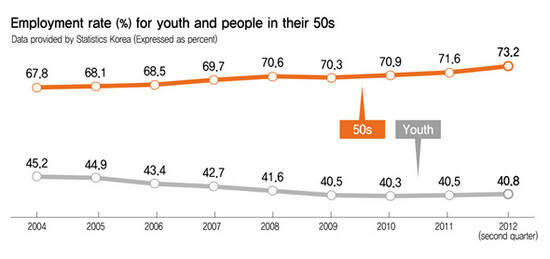hankyoreh
Links to other country sites 다른 나라 사이트 링크
The inconvenient truth about employment in 2012’s first half

By Choi Hyun-june, staff reporter
Lee Mi-young, 54, recently opened a coffee shop in Seoul’s Jungnang district Seoul. She invested her life savings and her husband’s severance pay. The business ran well for the first couple months. But it has been slowing down, after some other coffee shops opened around hers.
"I still have to make some money because my kids have not got a job yet,” said Lee. “I’m just going to do what I can.”
Bang Dae-young, 29, is still seeking a job. He has taken several recruitment exams to work in finance but hasn‘t found anything yet. He once sought a job in smaller companies, but those companies offer few entry-level positions.
“More than 20% of my friends who are still unemployed like me,” said Bang. “I become speechless when the government claims that the employment rate is soaring.”
According to the Economically Active Population Survey in June 2012 reported by the Statistics Korea on July 11, the country’s total workforce stood at 24.47 million in June, up 450 thousand people from the previous year and the highest mark in 8 years.
Especially, labor force participation rate was 60.2% for the second quarter of this year, the first time in four years it topped 60%.
“From last year, the Korean economy has shown a good improvement in job creation,” said a source from Ministry of Strategy & Finance. “It is mainly because of the increased employment of female and elderly people.”
But job seekers hardly feel the employment growth in reality. Most of the employed persons are in their 50s or elder and young people in their 20s and 30s are still facing a jobs crunch.
According to the survey, the number of the employed of their 50s and 60s increased 246 thousand and 222 thousand respectively, while of their 30s and 20s decreased 104 thousand.
The same situation can be found in labor force participation rate. The participation rate of 50s is above 70%, while the young (in their ages from 15 to 29) showed only 40% of it.
“It doesn‘t seem like the employment situation is good because young people are still struggling,” said Doctor Hwang Soo-kyeong from Korea Development Institute.
The overall participation rate has not recovered to the level seen before the 1997 IMF crisis. In 1997, the labor force participation rate was 60.8%, but it dropped to 58.6% in 2009 and now stays at 60.2% in the second quarter 2012.
The quality of employment for people in their 50s is quite mediocre. They tend to start running small businesses since the entry barriers are relatively low. According to the report ’Small Business Focusing on Low Added Value Worsens the Economy‘, by LG Economic Research Institute on July 10, the number of small business owners in their 50s increased by 175,000 between this January and May. The number accounts for 39% of the employment growth of the first half this year.
Most of them run coffee shops or restaurants that create low added value, leaning on cheap labor. Such business already has been a red ocean for a while and now it is getting worse.
“It is expected that the number of self-employed people will continue to increase for another few years as the baby boom generation retires,” said Ko Ga-young, researcher at the LG Economic Research Institute. “If this sluggish economy lasts longer, a lot of small business owners cannot help but close up shop.”
Under the effect of growth of small business, people employed in those businesses, especially those with fewer than 5 people, increased as well. They are reported over 10,000 thousand, taking 40% of the workforce.
“Due to the rise in businesses started by retired people, employment in small business is increasing,” said a source from the Statistics Korea. “But the quality of those positions is poor.”
Translated by Kim Ji-seung, Hankyoreh English intern
Please direct questions or comments to [english@hani.co.kr]

Editorial・opinion
![[Column] Has Korea, too, crossed the Rubicon on China? [Column] Has Korea, too, crossed the Rubicon on China?](https://flexible.img.hani.co.kr/flexible/normal/500/300/imgdb/original/2024/0419/9317135153409185.jpg) [Column] Has Korea, too, crossed the Rubicon on China?
[Column] Has Korea, too, crossed the Rubicon on China?![[Correspondent’s column] In Japan’s alliance with US, echoes of its past alliances with UK [Correspondent’s column] In Japan’s alliance with US, echoes of its past alliances with UK](https://flexible.img.hani.co.kr/flexible/normal/500/300/imgdb/original/2024/0419/2317135166563519.jpg) [Correspondent’s column] In Japan’s alliance with US, echoes of its past alliances with UK
[Correspondent’s column] In Japan’s alliance with US, echoes of its past alliances with UK- [Editorial] Does Yoon think the Korean public is wrong?
- [Editorial] As it bolsters its alliance with US, Japan must be accountable for past
- [Guest essay] Amending the Constitution is Yoon’s key to leaving office in public’s good graces
- [Editorial] 10 years on, lessons of Sewol tragedy must never be forgotten
- [Column] A death blow to Korea’s prosecutor politics
- [Correspondent’s column] The US and the end of Japanese pacifism
- [Guest essay] How Korea turned its trainee doctors into monsters
- [Guest essay] As someone who helped forge Seoul-Moscow ties, their status today troubles me
Most viewed articles
- 1[Column] The clock is ticking for Korea’s first lady
- 2Hong Se-hwa, voice for tolerance whose memoir of exile touched a chord, dies at 76
- 3After 2 months of delayed, denied medical care, Koreans worry worst may be yet to come
- 4[Column] Has Korea, too, crossed the Rubicon on China?
- 5US overtakes China as Korea’s top export market, prompting trade sanction jitters
- 6Samsung barricades office as unionized workers strike for better conditions
- 7All eyes on Xiaomi after it pulls off EV that Apple couldn’t
- 8[Correspondent’s column] In Japan’s alliance with US, echoes of its past alliances with UK
- 975% of younger S. Koreans want to leave country
- 10[Correspondent’s column] The US and the end of Japanese pacifism